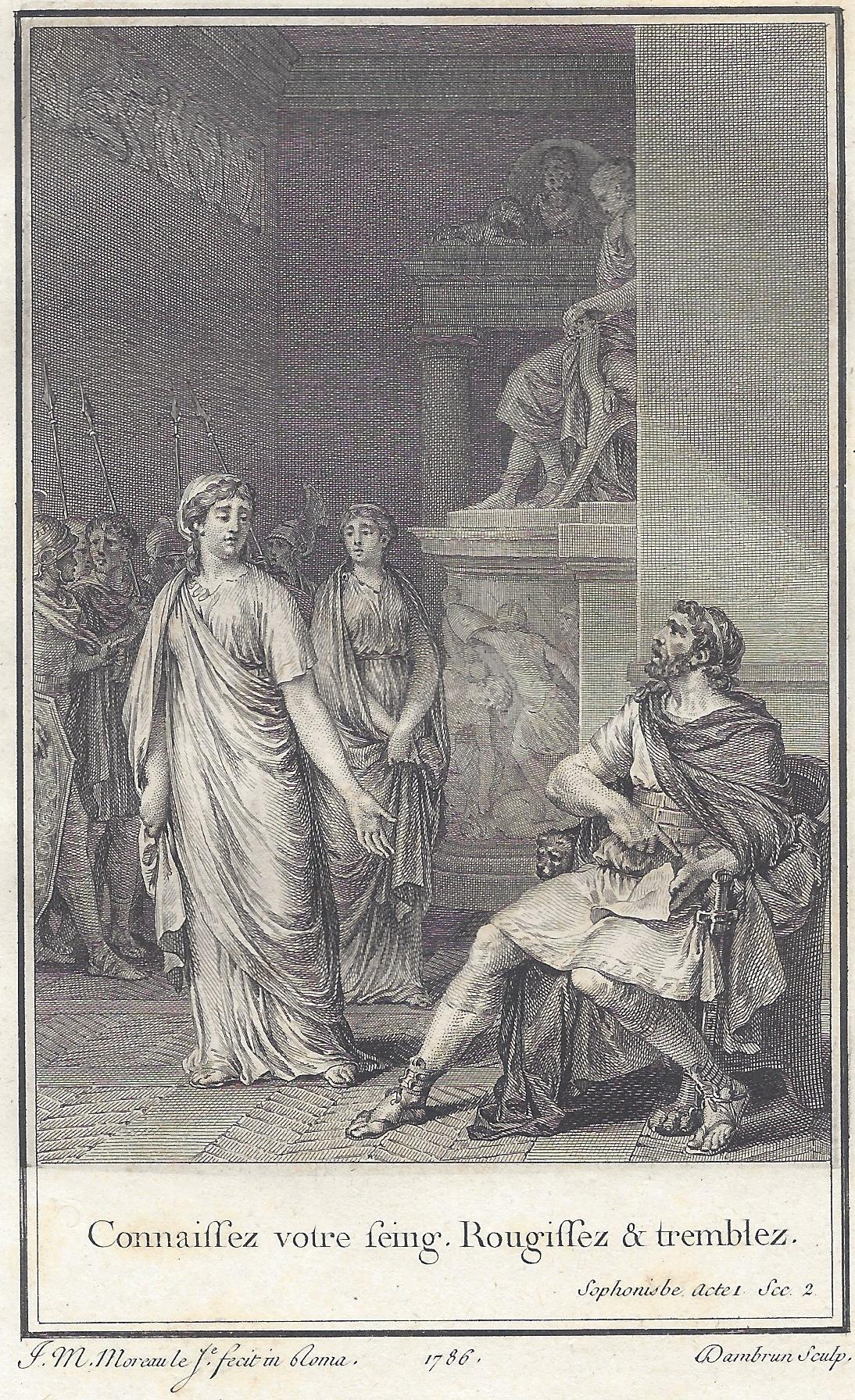Sophonisbe (tragedy) on:
[Wikipedia]
[Google]
[Amazon]
 '' Sophonisbe '' is a tragedy in five acts by
'' Sophonisbe '' is a tragedy in five acts by
full text of ''Sophonisbe''
scanned version of first edition
Literature on ''Sophonisbe'', Société des Etudes Voltairiennes
Plays by Voltaire Tragedy plays 1774 in France 1774 plays Phoenicia in fiction Cultural depictions of Sophonisba
 '' Sophonisbe '' is a tragedy in five acts by
'' Sophonisbe '' is a tragedy in five acts by Voltaire
François-Marie Arouet (; 21 November 169430 May 1778) was a French Enlightenment writer, historian, and philosopher. Known by his ''nom de plume'' M. de Voltaire (; also ; ), he was famous for his wit, and his criticism of Christianity—es ...
. The play, printed in 1769 but dated 1770, was a stage failure when it premiered on 15 January 1774.
Action
The action takes places in a hall of the palace ofCirta
Cirta, also known by various other names in antiquity, was the ancient Berber and Roman settlement which later became Constantine, Algeria.
Cirta was the capital city of the Berber kingdom of Numidia; its strategically important port city ...
at the time if the Second Punic War. Sophonisbe, daughter of Asdrubal (Hasdrubal Hasdrubal ( grc-gre, Ἀσδρούβας, ''Hasdroúbas'') is the Latinized form of the Carthaginian name ʿAzrubaʿal ( xpu, 𐤏𐤆𐤓𐤁𐤏𐤋 , , "Help of Baal").
It may refer to:
* Hasdrubal I of Carthage was the Magonid king of Ancien ...
) is married to king Siphax ( Syphax) of Numidia. Her former fiancé Massinisse (Massinissa
Masinissa ( nxm, , ''MSNSN''; ''c.'' 238 BC – 148 BC), also spelled Massinissa, Massena and Massan, was an ancient Numidian king best known for leading a federation of Massylii Berber tribes during the Second Punic War (218–201 BC), ult ...
) defeats and kills Siphax with the help of the Romans and wants to marry Sophonisbe; Scipion (Publius Cornelius Scipio Africanus
Publius Cornelius Scipio Africanus (, , ; 236/235–183 BC) was a Roman general and statesman, most notable as one of the main architects of Rome's victory against Carthage in the Second Punic War. Often regarded as one of the best military co ...
) however wants her sent to Rome. Massinisse therefore kills both Sophonisbe and himself.Vgl. Siegfried Detemple: ''Sophonisbe'', in: ''Voltaire: Die Werke. Katalog zum 300. Geburtstag.'' Reichert, Wiesbaden 1994, pp.220f.
Literary sources
The material for the plot derives from accounts byTitus Livius
Titus Livius (; 59 BC – AD 17), known in English as Livy ( ), was a Roman historian. He wrote a monumental history of Rome and the Roman people, titled , covering the period from the earliest legends of Rome before the traditional founding in ...
, Polybius and Appian
Appian of Alexandria (; grc-gre, Ἀππιανὸς Ἀλεξανδρεύς ''Appianòs Alexandreús''; la, Appianus Alexandrinus; ) was a Greek historian with Roman citizenship who flourished during the reigns of Emperors of Rome Trajan, Ha ...
, which had already been adapted into stage plays by a number of writers including Gian Giorgio Trissino
Gian Giorgio Trissino (8 July 1478 – 8 December 1550), also called Giovan Giorgio Trissino and self-styled as Giovan Giωrgio Trissino, was a Venetian Renaissance humanist, poet, dramatist, diplomat, grammarian, linguist, and philosopher.
...
(1514), Jean Mairet (1629), Pierre Corneille (1663) and Nathaniel Lee (1675). Analysis of the dramatic structure and the verse indicates that Voltaire drew on a number of earlier version of the story while crafting his own.
Contemporary reception
Voltaire succeeded in having the play premiered at theComédie-Française
The Comédie-Française () or Théâtre-Français () is one of the few state theatres in France. Founded in 1680, it is the oldest active theatre company in the world. Established as a French state-controlled entity in 1995, it is the only state ...
on 15 January 1774 but there were only four performances before it was taken off the stage.
The failure of both this and his other play ''Don Pèdre, roi de Castille
''Don Pèdre, roi de Castille'' (''Don Pedro, King of Castille'') is a tragedy in five acts by Voltaire. He began work on it in 1761 but only finished it in 1774. It was rejected by the Comédie-Française and published unperformed in 1775.
Acti ...
'' depressed him, and he took a break from writing tragedies until 1777, when he wrote '' Irène'' and '' Agathocle''.
Printed edition
Voltaire had arranged the printing of the work in late 1769 with the widow Duchesne in Paris. Publication followed at the end of that year, carrying the date 1770. The work was published with the title ''Sophonisbe, Tragédie de Mairet, reparée à neuf'', Veuve Duchesne, Paris, 1770. Voltaire added an explanatory preface in which he claimed that Mairet's work had been adapted by a certain Jean-Baptiste Lantin, who had died fifty years previously, but this is certainly spurious. It may be that Voltaire was uncertain about how the theatre-going public would respond to the play, and wished to distance himself to some degree from his own creation.{{cite web , last1=Malone Feige , first1=Camilla , title=Genesis and sources of Voltaire's "Sophonisbe" , url=http://digitallibrary.usc.edu/cdm/ref/collection/p15799coll39/id/281023, website=digitallibrary.usc.edu , publisher=USC Digital Library , access-date=1 November 2018References
External links
full text of ''Sophonisbe''
scanned version of first edition
Literature on ''Sophonisbe'', Société des Etudes Voltairiennes
Plays by Voltaire Tragedy plays 1774 in France 1774 plays Phoenicia in fiction Cultural depictions of Sophonisba